
1940 As an industry, Hollywood had reason to worry in 1940. Their once lighter than air dream that had seemed so sure-footed and eternal throughout the 1930s had been impacted and severely hampered at the end of 1939 by the outbreak of WWII in Europe. Overnight, the foreign market was gone. So too, were there cracks in that self-assured domestic box office return that had been practically guaranteed by some of Hollywood’s most galvanic commodities. For example: Shirley Temple had a most expensive flop with the glossy-fied Technicolor remake of The Blue Bird.
There were happier times to report, however: Gone With The Wind continued to exceed all box office expectations; Bette Davis scored another Oscar-nominated tour de force with William Wyler’s tale of deception and marital infidelity in The Letter. Davis lost her statuette to Ginger Rogers for Kitty Foyle. Ernest Lubitsch delighted audie
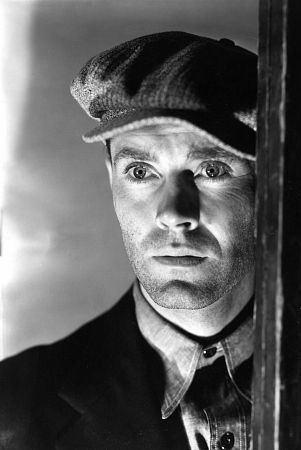 nces with his story of unrequited love set in a Budapest gift store in The Shop Around the Corner, and, Darryl F. Zanuck translated John Steinbeck’s epic literary achievement, The Grapes of Wrath into a box office winner for 20th Century Fox.
nces with his story of unrequited love set in a Budapest gift store in The Shop Around the Corner, and, Darryl F. Zanuck translated John Steinbeck’s epic literary achievement, The Grapes of Wrath into a box office winner for 20th Century Fox.Although Steinbeck, and purists of his novel, were fairly unimpressed with Zanuck’s rewrite for the movies (the book had focused on politics, the film on people – and with the added cliché of a ‘Hollywood’ ending tacked on for good measure), the finished work was nevertheless a very powerful and profitable film for the studio.
Hollywood continued to churn out its array of ‘bless our happy home’ screwball comedies. But their bite was more cynical in tone than it had been in the ‘30s. The big surprise over at Paramount was Preston Sturges’ The Great McGinty. Sturges, who had been a staff scriptwriter for several years, sold the story to the studio for a dollar on the confirmation that he would direct. It was the first time any writer had been afforded the opportunity, and, the film’s success ensured that Sturges would hold a special place amongst the Hollywood elite for several years to come.
Katharine Hepburn (whose fledgling film career had derailed after being branded box office poison in Variety magazine) strong-armed MGM into producing Philip Barry’s Broadway smash The Philadelphia Story for the big screen with her in the lead. The film’s success restored Hepburn’s reputation as a bankable star.

Howard Hawks directed the best version of Ben Hecht’s The Front Page, rewritten and recast to include a romance, as His Girl Friday. Walt Disney’s initial success in the field of animation suffered two hard-hitting financial blows that threatened to bankrupt the studio; following the abysmal performance of Pinocchio and Fantasia at the box office. Arguably, these two films were Disney’s most adult-orientated features – the first, superior in its art to Snow White & The Seven Dwarfs; the latter a miraculous blend of interpretive imagery flawlessly married to classical music. Sadly, the paying public was neither ready nor willing to embrace either achievement.
The dream officially turned darker with David O. Selznick’s follow up to Gone With The Wind: Alfred Hitchcock’s Rebecca. It took home the Oscar as Best Picture of the year. A gothic reworking of Jane Eyre, Rebecca was a brooding prelude to the film noir movement that would dominate theatre screens by decade’s end. So too did the gathering storm of Allied intervention in the war abroad, kick off a string of anti-Nazi melodramas beginning with MGM’s The Mortal Storm; Charlie Chaplin’s brilliantly re-conceived parody of Hitler, The Great Dictator, and, Hitchcock’s masterful espionage thriller, Foreign Correspondent. Death took silent greats Tom Mix, Marguerite Clark and Mack Sennett’s comedy genius, Ben Turpin.

1941 Despite the fact that half of Europe was rapidly being consumed in Adolph Hitler’s hemisphere of flames, the biggest news at home (at least as far as Hollywood was concerned) was RKO’s signing of wunderkind Orson Welles. Welles, the prodigal protégée who had terrorized radio listeners with his broadcast of ‘War of the Worlds’ had been given free reign to produce whatever project he desired. He desired Citizen Kane. A bleak investigation of one man’s moral decline into embittered isolation, certain aspects of the Citizen Kane bore more than a passing comparison to media mogul William Randolph Hearst. Outraged, Hearst plotted to buy up and destroy the film negatives even before its general release. Although Hearst failed in his overzealousness, his negative publicity did succeed in dismantling Welles’ reputation as a genius at RKO.
As for the rest of Hollywood’s yearly output – it was an interesting blend of high drama and powerful crime thrillers. The Maltese Falcon and High Sierra – both with Humphrey Bogart, catapulted Bogie’s reputation from salvageable second string gangster to mega-watt stardom. ‘Every man’ Gary Cooper had a pair of successes with Sergeant York and Frank Capra’s Meet John Doe. In December, Capra announced to the press that he would be leaving main stream film for the Cinema Services to produce military shorts. Although no one knew it at the time, Greta Garbo made her final appearance in the disastrous Two-Faced Woman – a poorly scripted comedy follow-up to the previous year’s Ninotchka. Vivien Leigh had a minor hit in That Hamilton Woman, costarring opposite real life husband, Laurence Olivier.
Warner Brothers produced a scathing account of small town deceptions with King’s Row. William Wyler – whose affair with Bette Davis had begun to cool – nevertheless gave his paramour another fine screen vehicle in which to exude her venomous intrigues; Lillian Helman’s The Little Foxes. Davis also excelled in The Man Who Came To Dinner. In August, the luminous profile of Ava Gardner was spotted in a photograph by MGM talent scouts who signed her to a seven year contract.
Spencer Tracy justly received the Best Actor Oscar for his portrayal of Father Flannigan in MGM’s tender melodrama, Boy’s Town – costarring Mickey Rooney. Nelson Eddy’s teaming with operatic soprano Rise Stevens in The Chocolate Solider failed to catch the public’s fascination as his previous and frequent costarring with Jeanette MacDonald had. Remakes of silent classics The Sea Wolf, Smilin’ Through and Blood and Sand did respectable box office. Judy Garland and Mickey Rooney made their most profitable film together: Babes on Broadway – a celebrated achievement whose one drawback from today’s vantage is the minstrel finale performed in ‘black face.’ New stars were Gene Tierney, Sterling Hayden and a pair of radio comedians making their mark over at Universal: Bud Abbott and Lou Costello.

Darryl F. Zanuck, whose desire it had long been to produce 20th Century-Fox’s first Oscar-winning Best Picture, at last emerged victorious with one of the best movies Hollywood has ever made; How Green Was My Valley – the bittersweet and heartfelt tragic familial saga set in a Welsh mining town. Originally, Zanuck had conceived the film as an expansive Technicolor extravaganza, akin in scope and length to Selznick’s Gone With The Wind (which was still going strong at the box office). Studio cut backs and war time rations prevented Zanuck’s vision, though not his dream, from reaching fruition. In black and white and with A-list production values, Zanuck’s version of Richard Llewellyn’s novel easily became both the personal and professional triumph, winning the Best Picture Oscar.
1942 The year began with a tragedy on January 16th; the death of gifted comedienne Carol Lombard in a plane crash while returning home from a war bond rally. Emotionally shattered by the loss of his wife, Clark Gable enlisted in the military and consequently ended his supremacy as ‘king’ of the movies. Warner Brothers breathed a quiet sigh of relief when one of their most profitable pretty boys, Errol Flynn was acquitted of the statutory rape of two minors. The trial did little to tarnish Flynn’s reputation as a stud, though it did leave the actor with the rather unflattering moniker, “in like Flynn.”
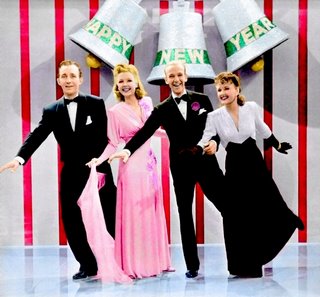
To help ease the sting of war on the home front, Hollywood temporarily returned to more light-hearted and profitable venues; the moralist melodrama screwball comedy The Talk of the Town, The Major and the Minor, and the gregariously patriotic Yankee Doodle Dandy. Irving Berlin’s Holiday Inn became a smash hit with a string of hotels named after it. Berlin had conceived the scenario of an inn open holidays only and had provided all the music for the score, including the throw away tune that rapidly became a million seller; White Christmas, inimitably sung by Bing Crosby.
Fred Astaire proved he could dance minus Ginger Rogers, tripping the light fantastic with Rita Hayworth in You Were Never Lovelier – a classy South American musical romp, and with Eleanor Powell, in Broadway Melody of 1940. In August, Darryl F. Zanuck shocked his board of directors by resigning as head of production at 20th Century Fox and becoming a colonel in the Signal Corps.
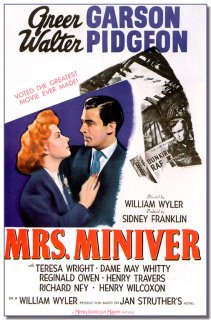
The studios plunged headstrong into propaganda films designed to bolster America’s support for involvement in the war. The best remembered of these was Mrs. Miniver, a film illustrating the quiet home front hardships of a proper English housewife (Greer Garson) and sited by Winston Churchill as being more effective at gaining support for the Allies than a fleet of destroyers. Garson, who had made her American debut in Goodbye, Mr. Chips (1939) had another major hit on her hands this year with the bittersweet tear jerker, Random Harvest.
Orson Welles tried to bring Booth Tarkington’s The Magnificent Ambersons to the screen with all its incestuous debauchery in tact, but was hampered in his efforts by RKO’s declining faith in his abilities and by his premature removal from the project. It was reshot and reedited after Welles departure from the studio to include a happy ending. Reeling from the sting of Welles’ extravagance, RKO appointed producer Val Lewton as head of production and gave him the worst title for a film – Cat People. Undaunted, Lewton reworked the screenplay and transformed this modestly budgeted horror flick into a sublime and terrifying thriller that rang cash registers around the country.
Bette Davis made everyone cry in Now Voyager, the tale of a repressed society matron transformed by love and understanding into a lady of culture. After a dry spell at the box office, the Disney Studios emerged back on top with their tender and poignant Bambi. Luminaries Edna May Oliver, May Robson, composer and Broadway showman George M. Cohan and ‘the great profile’ John Barrymore also passed away before year’s end.
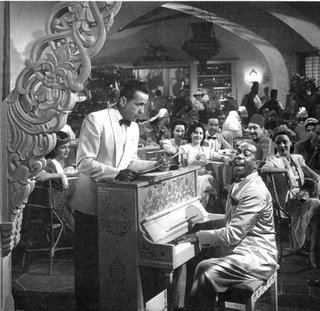
1943 More than any other year from the decade, war time propaganda films dominated Hollywood’s output; Bataan, Destination Tokyo, A Guy Named Joe, The Human Comedy, So Proudly We Hail and The Cross of Lorraine being among the best. MGM made Thousand’s Cheer – a loosely plotted vignette musical that served to showcase its supremacy in star power. But it was Irving Berlin’s contribution to this glossy musical off shoot; This Is The Army, that was the real/reel achievement of the year; featuring an all star cast, hundreds of personnel from the Armed Forces and fifteen show stopping numbers, including Kate Smith’s rousing God Bless America. Although the New York Film Critics chose the brooding and intense Watch on the Rhine as their Best Picture, the much publicized political conference between Roosevelt, Stalin and Churchill in Casablanca made Warner Brothers' Casablanca the chosen one at the Academy Awards.
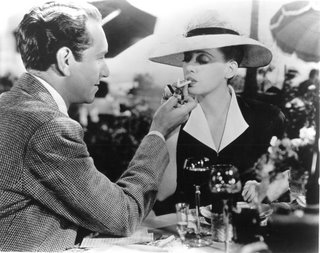
Hollywood gambled on two all black musicals; MGM’s Cabin in the Sky and Fox’s Stormy Weather – neither seemed to expand the boundaries for non-Caucasians, though each film yielded some very fine performances. Both were boycotted from exhibition and general release in the southern states. Under contract to David O. Selznick, fledgling actress Jennifer Jones emerged triumphant on loan out to Fox for Franz Werfel’s The Song of Bernadette. Val Lewton produced an even more disturbing horror flick with I Walked With A Zombie. The other impressive entry of the season, Lassie Come Home (the first in the series) costarred two British war refugees cum Hollywood child stars; Roddy McDowell and Elizabeth Taylor. Mickey Rooney and Judy Garland made their final on screen appearance together in Girl Crazy. Midway through production Garland suffered a breakdown brought on by her studio sanctioned addiction to prescription sedatives.
Technicolor continued to gain prominence within the industry. Universal thought the gimmick of color enough to sustain its lavish remake of The Phantom of the Opera – it wasn’t. The year was rounded out by another war time tragedy – the loss of British matinee idol and sometimes Hollywood star, Leslie Howard in a plane crash while on a mission for the British secret service.

1944 Determined to extol contributions made to the war effort on the home front, David O. Selznick created an epic weepy, Since You Went Away. A lengthy (3 hr plus) examination of trials and tribulations far from the battlefield, the film starred a reluctant Claudette Colbert (who thought she might be typecast in more matronly roles afterward). Alfred Hitchcock delivered another brilliant propaganda/suspense thriller with Lifeboat; the daring sea saga entirely shot on one set about eight survivors of a German U-boat attack. Oddly enough, critics of the day misconstrued the intent of the film as un-American. It was quickly pulled from circulation.
By now, many of Hollywood’s most prominent leading men had traded their plush tweeds for military gray. James Stewart became a major; Clark Gable – a captain. Marlene Dietrich was a one woman USO – committing the bulk of her waking hours and career to a relentless schedule of entertaining the troops. Their absences from the screen were compensated for in the public’s estimation by scorching debuts of Lauren Bacall in To Have and Have Not and every man of integrity, Gregory Peck in Days of Glory. Elizabeth Taylor made her mark in National Velvet. Preston Sturges had another hit on his hands with the screwball comedy, The Miracle of Morgan’s Creek – the rather risqué story of a woman who can’t remember how she became pregnant.
Other outstanding releases of the year included Vincente Minnelli’s brilliant reconstruction of turn of the century Americana – Meet Me In St. Louis; mysteries, Laura and Gaslight; the exceptional film noir, Double Indemnity; the effervescent musical, Cover Girl, starring Gene Kelly and Rita Hayworth, and Leo McCarey’s tear jerker, Going My Way for which film and star Bing Crosby won the Academy Award.
Darryl F. Zanuck made a brilliant attempt to immortalize the legacy of President Woodrow Wilson in ‘Wilson’ – a film that unfortunately tanked at the box office and strained Zanuck’s reputation for excess at the studio. Disappointing also was the tepid Technicolor film version of Broadway’s smash – Lady in the Dark, starring Ginger Rogers. MGM unleashed an unlikely star in champion swimmer Esther Williams. Williams’ screen debut in Bathing Beauty marked the beginning of a 26 aquacade film association with the studio.
No comments:
Post a Comment